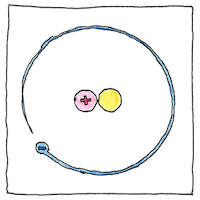Harold Urey,
George M. Murphy,
Ferdinand Brickwedde
chemistry

|
Deuterium
They thought that hydrogen had heavier isotopes but the neutron hadn’t been discovered, so they thought hydrogen could have added “nuclear electrons.” Harold Urey worked with colleagues to find them, distilling lighter fractions from liquid hydrogen until a spectroscope was able to identify the mass-2 isotope.
Naming deuterium
From the Greek deuteros (meaning second) Lewis suggested deutium. From the Greek diploos (meaning double) Rutherford suggested diplogen. Urey named the mass-1 isotope protium, containing a proton from the Greek protos (meaning first). He named the mass-2 isotope deuterium, containing a proton and one neutron from the Greek deuteros (meaning second). And he named the mass-3 isotope tritium, containing a proton and two neutrons from the Greek trítos (meaning third).
Operation Gunnerside
16 February 1943. Vemork plant in Telemark. Dramatic music stresses matters of life and death. The Norwegian resistance sabotages the hydrogen plant to keep heavy water from the Germans who want it for hydrogen bombs. Black and white move in shadows of night.



Ordinary hydrogen, lacking neutrons, does not initiate fusion in a nuclear bomb. When an initial nuclear explosion bombards cryogenic hydrogen or lithium deuteride, it produces tritium, and the deuterium and tritium engage in thermonuclear fusion, creating hydrogen-4 and releasing tremendous energy.
See also in The book of science:
Readings in wikipedia: